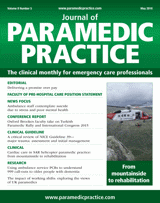References
Continuing Professional Development: Understanding paramedic treatment and management of pulmonary embolism
Abstract
Overview
Pulmonary embolism (PE) is one of the most common preventable deaths in the UK. Causing occlusion of the pulmonary arteries, a PE is most often the result of the formation of a deep vein thrombosis (DVT) which ‘breaks free’ and travels to the lungs where it alters the normal ventilation/perfusion (V/Q) relationship, resulting in hypoxia, increased dead space and intrapulmonary shunting.
This Continuing Professional Development (CPD) module will explore the pathophysiology, assessment and management of PE by paramedics, and explore the condition's main causes and treatment from the paramedic's perspective.
Learning Outcomes
After completing this module you should be able to:
Provide a definition of pulmonary embolism (PE).
Identify the common causes of PE.
Identify the key steps in performing a respiratory assessment.
Outline how the paramedic can treat and management a patient with a PE.
The airway is divided into two broad sections, namely the upper and lower airway. In the case of airway management it is vital that the paramedic has a good working knowledge of the anatomy and physiology of the upper airway. Normal natural breathing occurs through the nose, this is for a number of reasons. One of the most important reasons is the role of structures within the nasal passage and nasopharynx. Within the nasal passage, structures called turbinates moisten and humidify the air that is breathed before it travels into the lower airway, this ensures that inspired air is warmed when it reaches the lower airway (Tortora and Derrickson, 2014). Without this mechanism inspired air would be cold and have a profound effect on core body temperature. In order to humidify inspired air during normal breathing the turbinates will use 1 litre of fluid a day (Hagberg, 2007), therefore patients in respiratory failure, such as chronic obstructive pulmonary disease (COPD), will use a great deal more fluid, but unfortunately due to the difficulty they have to drink while breathless they tend to be chronically dehydrated.
Subscribe to get full access to the Journal of Paramedic Practice
Thank you for visiting the Journal of Paramedic Practice and reading our archive of expert clinical content. If you would like to read more from the only journal dedicated to those working in emergency care, you can start your subscription today for just £48.
What's included
-
CPD Focus
-
Develop your career
-
Stay informed

